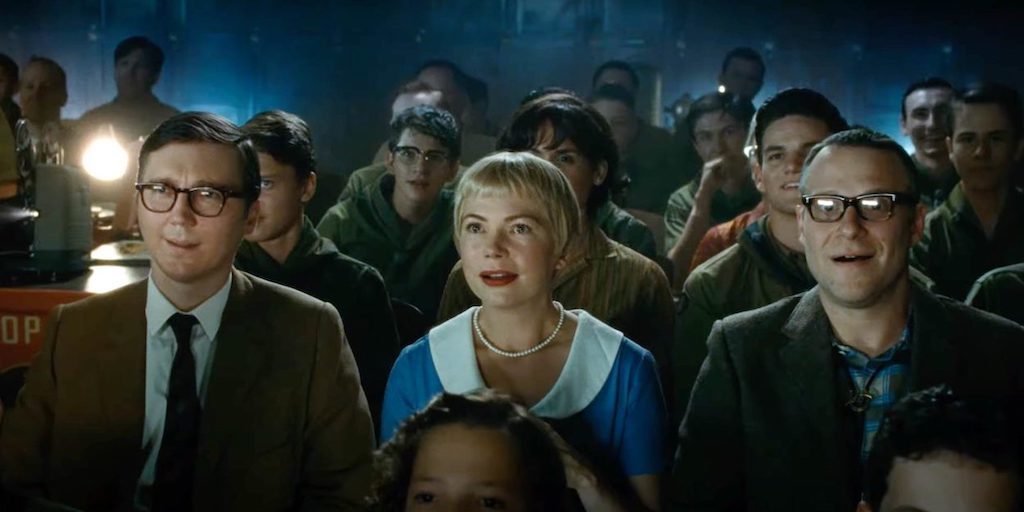THE ENGINEER’S SON
It is impossible to spoil this movie, so I’m going to start by telling how it ends. The protagonist, an alter ego of Spielberg as a teenager, wants to make movies and gets John Ford to grant him five minutes of his time at his office. The master, portrayed by a very funny David Lynch, asks him what he sees in two paintings hung on the wall. Sammy Fabelman describes the paintings but Ford shuts him up, telling him that he is talking about art and asks him where the horizon is. Sammy answers that in one painting it is at the top of the frame, and in the other it is at the bottom of the frame. Ford explains: “When the horizon is at the bottom, it’s interesting. When the horizon is at the top, it’s interesting. When the horizon is at the middle, it’s boring as shit.” He wishes him good luck and yells him to get out of his office. Sammy walks out of there elated of having known the great Ford and Spielberg frames him with his back to us walking down the studio lot at the very middle of the frame. Then remembers the advice and corrects the shot, so the protagonist is at the very bottom and the sky occupies much more room at the top.
This final scene contrasts with the one at the beginning. In the latter, Sammy’s parents take him to the movies for the first time. The kid does not want to get in because he is scared to walk into a dark room. His engineer father cannot think of a better argument to persuade him than explaining how film projection works. Finally, they persuade Sammy to get inside and watch Cecil B. DeMille’s The Greatest Show on Earth and, naturally, Sammy is fascinated with it, especially with the scene of a train wreck. From then on, the young Fabelman, shy with girls, bad at algebra and sports, will dedicate his utmost efforts to learn how to make movies. His father opposes to this because he does not want his son to dedicate his life to something so immaterial but, however, Sammy’s approach to cinema is that of an engineer that wants to know how you shoot a film and how you can make things seem real on the screen. The encounter with Ford and his intangible advice works as a way of saying that cinema is not just its construction or its themes, but it has to do with paying attention to the form and with something called art.
It is not clear if art is for Spielberg the same thing that it is for Ford, but the parallel between both scenes express more than a certainty, a concern, a question, even a contradiction: Why shooting the character at the middle of the frame can kill the interest art can awaken and why changing the angle can revive it? The answer very well may be that showing a bigger portion of the sky, as John Ford does at the end of Young Mr. Lincoln, may allow the introduction of time and spreading it open towards the future. But it also marks the apparition of a mystery that the centered shot closes upon explaining everything. By moving the camera, young Fabelman faces his future as a filmmaker the same way Lincoln faced his future as a politician. A future, on the other hand, more uncertain than it is definitive.
And all this because of not framing the characters at the center. However, the film itself prevents comparing Ford to Spielberg. Because The Fabelmans has a lot of predictable things, of conventional things. But, at the same time, it allows us to see how its director confronts the material he has chosen, that of his own life, his family’s and his learning of the craft. And right there is where the film becomes more complex, more open to doubt, and even to the possibility that Spielberg is telling us something different than what it might appear. And that has nothing to do with the autobiographical. I ignore how much there is of Steven Spielberg in Sammy Fabelman, but it is less important than knowing what Spielberg wants to tell and how. The film has a narrative thread, which is the protagonist’s relationship with movies, since his initial bedazzled discovery up to the decision of making it his career, going through the different stages of his evolution as an amateur filmmaker, the cameras and the editing equipment accompanying his progress.
On the other hand, the movie tells two episodes. One has to do with the Fabelman family, which in the first scenes seem to be a typical happy Jewish-American family. A father who is a professional on the rise, a mother who is a housewife that left her piano practice to take care of the children. Michelle Williams plays the part of the mother as if she was Doris Day. But behind this luminous appearance there are two dark beacons. The first is that she renounced her artistic calling to accompany his husband, much to the dismay of Uncle Boris, whose apparition at the Fabelman home will be little Sammy’s first encounter with the idea of art. Boris left his home to join the circus, sticking his head into a lion’s mouth. “That is art?” asks his nephew. “No,” answers Uncle Boris, “Sticking your head in the mouth of lions was balls. Making sure the lion don’t eat my head? That is art.” The joke is rather rude, but it bears the same characteristic as John Ford’s boutade: art is something unexpected, undefined, a vague idea that complements engineering, which at the same time allows to make things. Even if it goes against what that engineering advices. Spielberg’s position about that is weird: if you carefully analyze both scenes, Sammy attends to a lecture he might not fully understand but knows he needs to take into consideration. As a director, Spielberg always was something more akin to an engineer than he is to a poet, but he was not quite totally an engineer.
Anyhow, he always was some sort of bland engineer, more oriented to software than hardware as his friend George Lucas was, decidedly a friend of the hot rods and a filmmaker without inspiration. What welds Spielberg’s engineering aspect with his artistic intuition is the narrative: the emotional stories he likes to tell, always halfway between sentimentality and the sadness associated with loss (a loss that, as warned by Uncle Boris, in the case of art is associated with distance towards family). The second dark factor of the Fabelman model family is that the mother is in love with Ben, the father’s best friend, which is also his employee. Before it ceases to be a secret to the family, Sammy finds out about this because of movies: upon filming a picnic, the camera reveals that Ben and Mitzi experience an irresistible passion, although not consumed, but leads her to divorce and the leaving of his children. The mechanical image serves, like in Antonioni’s Blow-Up (or Cortazar’s The Devil’s Drool), to uncover the truth invisible to the eye.
Spielberg explores another use for cinema in that episode, that of its relationship to truth, which will have a continuation, further down the runtime, during the second half of the film that takes place in California where Sammy goes to high school among Anti-Semitic blondes. There, the boy suffers the martyrdom on account of the usual bullies and is barely compensated by the attraction he awakens in Monica, a girl as catholic as she is willing to release her hormones. By this instance, Sammy is the kid that makes movies, first with his friends in Arizona, then in school, until finally graduating, in a symbolic manner, during prom night (another classic motif in American cinema that Spielberg uses to a one-sided end) where he presents his movie (again shot outdoors, this time around with his classmates at a beach) in which the star is a blonde boy named just like him but is his opposite: a champion in every sport, the fastest, and an absolute ladies man. Sammy’s film shows Sam as some sort of Aryan superhero but the protagonist realizes that the adulation the film seems to dedicate is nothing more than a caricature denouncing him as a fraud, which is how he truly feels. The story seems to be taken from stories by Henry James in which a painting has the property of making those portrayed encounter with a face they do not want to see or do not want anyone else to see.
And that is Sammy Fabelman’s path before encountering John Ford. Cinema as a game, as technique, as entertainment, as medium to stand out from the crowd and, at the same time, cinema as vigilance of reality, an exposition of lies, as an approximation to art, which two generations of Fabelmans at least have repressed in the realm of fiction. There is a permanent ambiguity in Spielberg, a filmmaker that always practiced some sort of expressive shyness, that of a director within an industry that seems to think that cinema hides a mystery with which you should not mess a lot. His is an intermediate art, confident about his execution, doubtful as for his reach and respectful towards his history. The Fabelmans, with his way too schematic moments, is not his best film, but has a place in his filmography.
![]()
(United States, India, 2022)
Directed by: Steven Spielberg. Script: Steven Spielberg, Tony Kushner. Cast: Michelle Williams, Paul Dano, Seth Rogen, Gabriel LaBelle, Judd Hirsch, David Lynch. Production: Tony Kushner, Kristie Macosko Krieger, Steven Spielberg. Lenght: 151 minutos.













